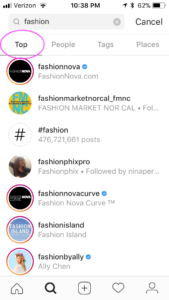If your brick and mortar business is on social media, using hashtags is a must in order to reach your target audience, grow your following, and engage with people out there in the cyberspace. They are great tools for creating brand awareness, community, and a conversation about your brand or company. But let’s start at the very beginning and talk about what the heck a hashtag actually is.
What is a #
A hashtag is a word or phrase preceded by the hash or pound sign (#) and is used to associate, attach, or categorize messages or posts to a topic. When used strategically, hashtags can highlight, among many other things, an aspect of your business, a benefit of your products, the customers who use your products, and events you host.
While each social media outlet has its own way of working with hashtags, the general result is a single stream of conversations, pictures, and posts that used a specific hashtag. For the purposes of this article, I’ll focus on the use of hashtags on Instagram and cover a few commonly asked questions, tips, and ideas.
How to create and use hashtags
Let’s start building! When constructing hashtags, you can use words strung together, but NO spaces (e.g. #nospaces) To help distinguish between words, you can use initial caps (e.g. #NoSpaces), because hashtags are not case sensitive and the caps won’t alter your search results. Furthermore, punctuation marks are no-no’s: no commas, periods, exclamation points, question marks, apostrophes, and so on. You get the picture. The hash sign doesn’t like being upstaged!
For many of you, the question may not be “What’s a hashtag?” but “Which hashtags do I use?”. Here are four guidelines to follow when selecting hashtags.
First, they should be relevant to your post as well as your business. If you’re posting a cashmere sweater, #bikinis might be confusing to your audience.
Second, use only 3-5 of the “big” hashtags. By “big” I mean those that are general and most often used. For example, #fashion (445 million posts) #ootd (Outfit Of the Day and has 156 million posts) or #instafashion (70 million posts). Because these get used often by so many people and companies, your post may get lost among the millions of posts. While you do want to throw your post into the ring with the big guys, you can balance it out by utilizing hashtags that can be more targeted for your business, product, or location.
Do the research
This leads nicely into our third point: research hashtags before you use them. Look at the hashtags being used by your successful competitors and brands in your category on Instagram. Jot down the hashtags you think would work for your business and attract the right eyes onto your account. Then look them up in the search function and take a look at the posts curated in that hashtag. Does it look like your target audience? Does it look like where your target audience would hang out or what they would search for? Also use the search function to find related hashtags that might also work. They will appear just below the search bar once you’ve typed in the hashtag you’re searching. Notice there are four categories under the search bar: Top, People, Tags and Places. You’ll want to look under Tags. But while we’re talking about it, notice Places. You can look at the top posts by geo tags. Remember my article about Geo Tagging? If not, go back and re-read it. It’s a good one. 🙂




Organizing your hashtags
By now you’re probably wondering how to keep track of all these great hashtags you’re finding. I strongly suggest creating some kind of document that you can access from your phone, since most of the time we post from our mobile devices. You can group them by topic, brand, event, etc. Once they are organized on your document you can simply cut and paste.
Another option, if you remember from my Top Apps I use Everyday post, is Planoly. A great tool to plan your instagram posts and to create groups of hashtags. Super convenient.
Hashtags are essential for creating a following, encouraging engagement on your account, and increasing your visibility on SM. There are no magic hashtags – just ones that speak to your target audience. Your hashtag lists will be fluid and changing. Don’t stress about them. Just do your homework in the snippets of time you have and add to your list when you find good ones.
Stay tuned for part 2 where we get into more advanced options! Meanwhile, feel free to bounce ideas off us here and happy hashtagging!!
